Scientists found 13 new viruses in Antarctica that impact humans
Scientists have found 13 new viruses in distant areas of Antarctica and two viruses of them may be harmful to humans. Scientists from Arizona State University (ASU) conducted this research.
They researched Weddell seals in the McMurdo Sound region of Antarctica over two years. They identified the HPV (Human papillomavirus) family of viruses there. HPV is a common sexually transmitted infection.

Hence, these microscopic creatures (viruses) can infect mammals, birds, reptiles, and humans. The viruses were discovered in 109 vaginal and nasal swabs (tests to check bacteria and virus presence) that scientists collected between 2015 and 2017.
A second-year PhD candidate Melanie Regney is the lead author of this research study. She expressed excitement about discovering the viruses in organisms that previously escaped the attention of scientists.
Melanie stated there are viruses everywhere. They are the most plentiful creatures in the universe. They are among the things they know the least about.
According to Melanie, the entire continent of Antarctica is incredibly unexplorable. Since it is the only one humans have not impacted significantly; they don’t know much about it. However, understanding the functioning of the environment in Antarctica requires a thorough investigation of its evolutionary history.
The team of scientists led by Melanie found 13 new viruses, 11 of which are completely new viral kinds. They have also warned against threats by viruses hidden beneath ice caps in the Arctic and other regions (Antarctica).

Click here to read updates on Scientists detected seven ghost particles at the South Pole
They warned that “zombie viruses” might cause a catastrophic worldwide health disaster. Hence, the melting ice of the Arctic can release these viruses.
However, Scientists use the term Zombie for those viruses that have been inactive for a long time. They may potentially spread serious diseases. Scientists have also restored these viruses that have been inactive for tens of millions of years in Siberian ice.
The journal Virology has published this research study that will also help in understanding the evolution of HPV by future scientists.
Read More:
- Sea creature turns into a baby when it is stressed out showing time travel
- Realme Narzo 70 Turbo 5G launch date, features, specifications & price
- European Space Agency printed 3D metal part in space for first time
- Earth’s mysterious Alaska triangle where over 20,000 people disappeared
- Philips Hue launched a new smart lighting solution for kitchen
- NASA to launch life-searching spacecraft to Jupiter’s moon Europa
Share this content:










Post Comment